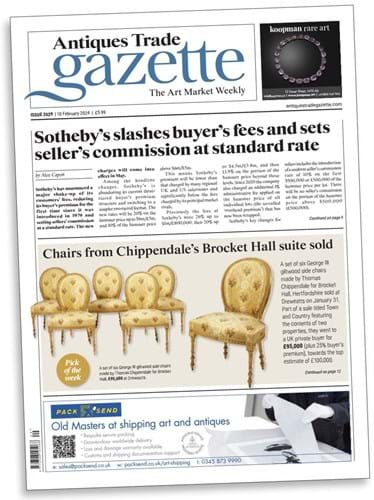It was Sotheby’s and Christie’s that introduced the buyer’s premium in 1975; 49 years later you might think the horse has already bolted on this topic with regular buyers at auction setting themselves a budget and determining the hammer price they can afford. But members of the trade remain determined to argue their case against the buyer’s premium.
The Letters page of ATG provides a platform for informed comment and, in the interests of sharing with you the latest discourse, even if it is focused on an old chestnut, here is a selection of what we received.
Regular readers will recall that ATG convened a roundtable of auctioneers and dealers in issue No 2358 to discuss the matter of both auction fees and dealers’ mark-ups. As a subscriber, you can find that informative discussion in our online archive where all sides of the debate were fairly represented and eruditely put forward.
Letter 1: Buyers always factor in costs
May I be so bold as to suggest that the sole reason for the alteration is for the benefit of the auction house not either the seller nor the buyer.
Irrespective of the justification by the auction house, the decision will not alter the buyer’s ultimate decision on how much to bid for the item.
The buyer has always lowered their bid to allow for whatever is the premium at the time of the auction.
This lowers the amount the sellers will receive for the item they are disposing of.
It is a sad reflection on the auction houses that when they introduced the buyer’s premium, they could not see what effect their decision would have for the sellers.
It is also illegal under UK law to have two Masters – a point made, if I recall correctly, by David Mason at the time of the BP introduction.
AR Fuller
Letter 2: Auctioneer acts for the vendor
I so agree with my old friend David Mason [quoted in our story, News, ATG No 2630] and would also welcome the abolition of the buyer’s premium.
Years ago when the premium was first introduced I wrote (I was then a practising solicitor) to the press saying that it was wrong: the auctioneer is agent for the vendor not the purchaser. As a collector of many years, I admire what our auction houses do; I would admire them more if I did not have to pay a large premium, perhaps some administrative charges.
Geoffrey C Bond, OBE, DL, FSA
The Geoffrey Bond Consultancy
Letter 3: Prices are opaque
My view on buyer’s premium is that there is role here for Trading Standards.
What other business is permitted to state a sale (hammer) price which is short in reality against what is invoiced?
The solution should be for the auctioneer to announce or display in real time what a buyer will actually pay, as is done already with currencies in the larger rooms and it’s not beyond the wit of auctioneers to make that simple calculation with the assistance of a pocket calculator.
It is particularly galling when an enticing cheap estimate hammer price is announced, quickly followed by a realised price for the same result eg £1000 net bid and opposed to, say, £1350 gross.
Doubtless similar views have been aired but I think it timely to reiterate the situation a buyer faces under present arrangements.
Bring back the guinea I say!
Clive Rogers
Clive Rogers Oriental Rugs, Stroud















